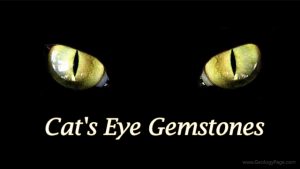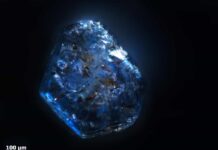
Translucent yellowish chatoyant chrysoberyl is called cymophane or cat’s eye. Cymophane has its derivation also from the Greek words meaning ‘wave’ and ‘appearance’, in reference to the haziness that visually distorts what would normally be viewed as a well defined surface of a cabochon.
This effect may be combined with a cat eye effect. In this variety, microscopic tubelike cavities or needle-like inclusions of rutile occur in an orientation parallel to the c-axis, producing a chatoyant effect visible as a single ray of light passing across the crystal. This effect is best seen in gemstones cut in cabochon form perpendicular to the c-axis. The color in yellow chrysoberyl is due to Fe3+ impurities.
Although other minerals such as tourmaline, scapolite, corundum, spinel and quartz can form “cat’s eye” stones similar in appearance to cymophane, the jewelry industry designates these stones as “quartz cat’s eyes”, or “ruby cat’s eyes” and only chrysoberyl can be referred to as “cat’s eye” with no other designation.
Gems lacking the silky inclusions required to produce the cat’s eye effect are usually faceted. An alexandrite cat’s eye is a chrysoberyl cat’s eye that changes color. “Milk and honey” is a term commonly used to describe the color of the best cat’s eyes. The effect refers to the sharp milky ray of white light normally crossing the cabochon as a center line along its length and overlying the honey-colored background. The honey color is considered to be top-grade by many gemologists but the lemon yellow colors are also popular and attractive. Cat’s eye material is found as a small percentage of the overall chrysoberyl production wherever chrysoberyl is found.
Cat’s eye really became popular by the end of the 19th century when the Duke of Connaught gave a ring with a cat’s eye as an engagement token; this was sufficient to make the stone more popular and increase its value greatly. Until that time, cat’s eye had predominantly been present in gem and mineral collections. The increased demand in turn created an intensified search for it in Sri Lanka.
The most famous and valuable cat’s eye gemstone is chrysoberyl cat’s eye. In fact when the term cat’s eye is used alone in the gem trade, it always refers to chrysoberyl cat’s eye. All other types of cat’s eye gems require an additional varietal designation, such as cat’s eye apatite.
Note: The above post is reprinted from materials provided by Wikipedia.










